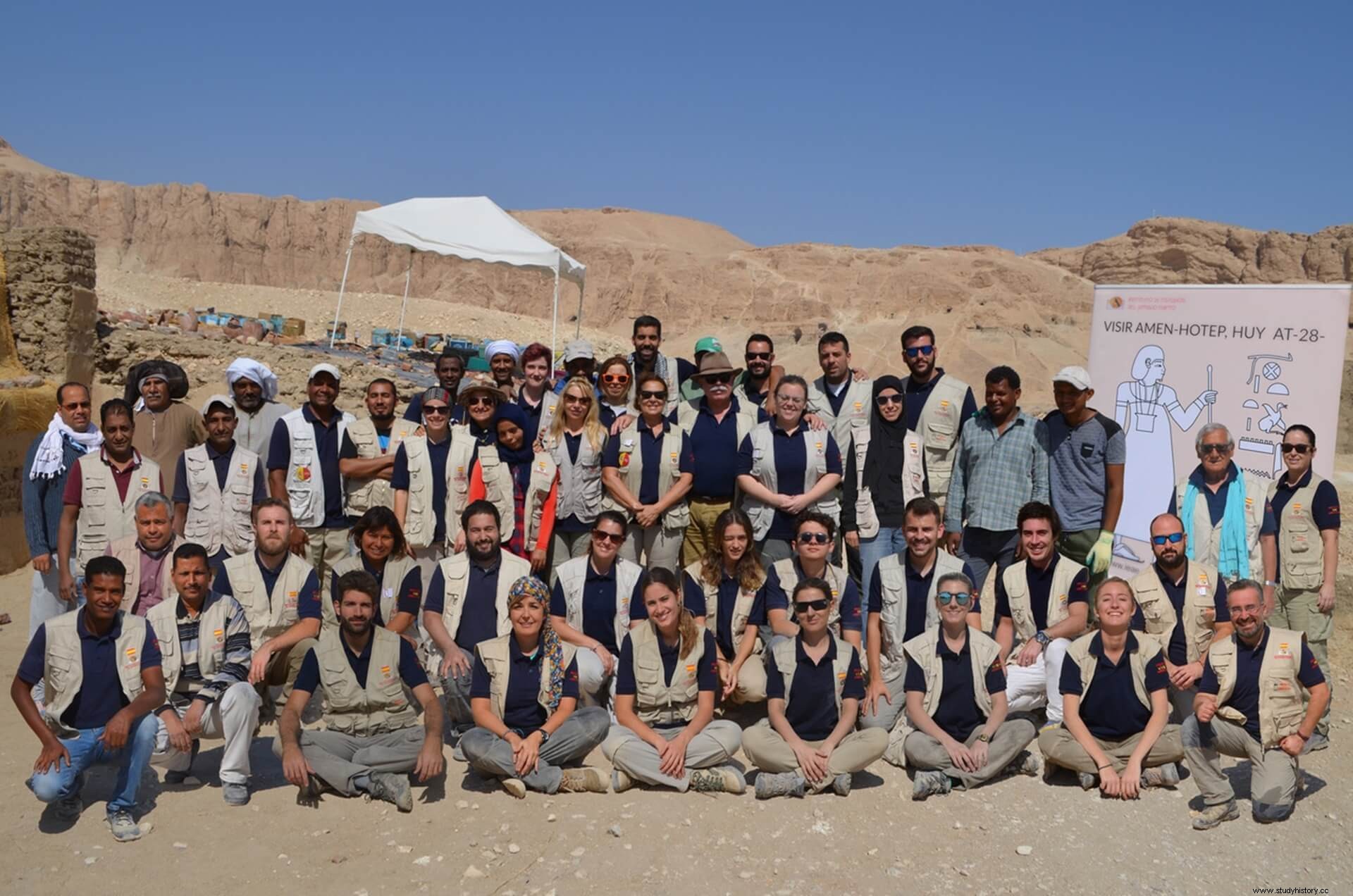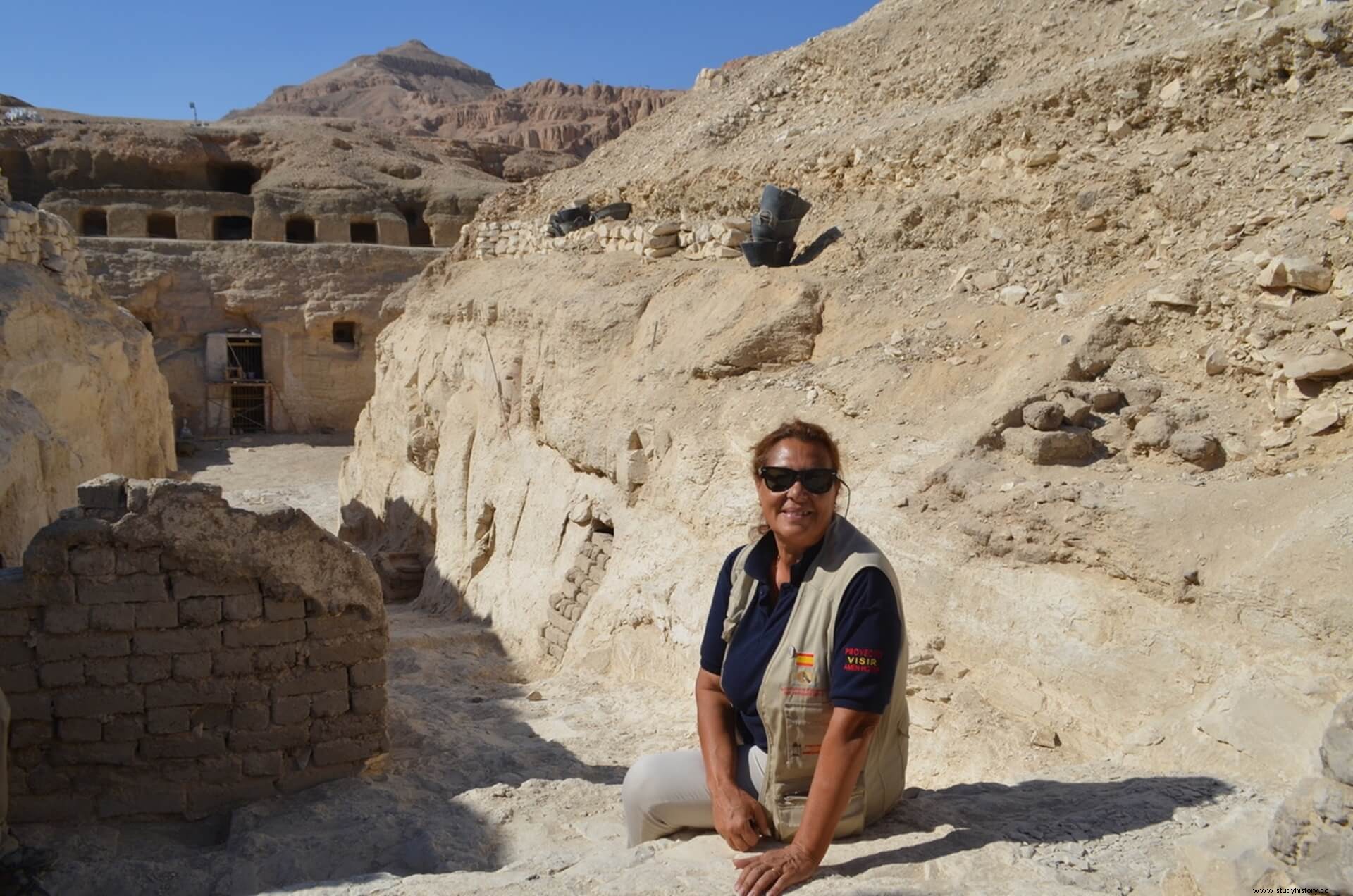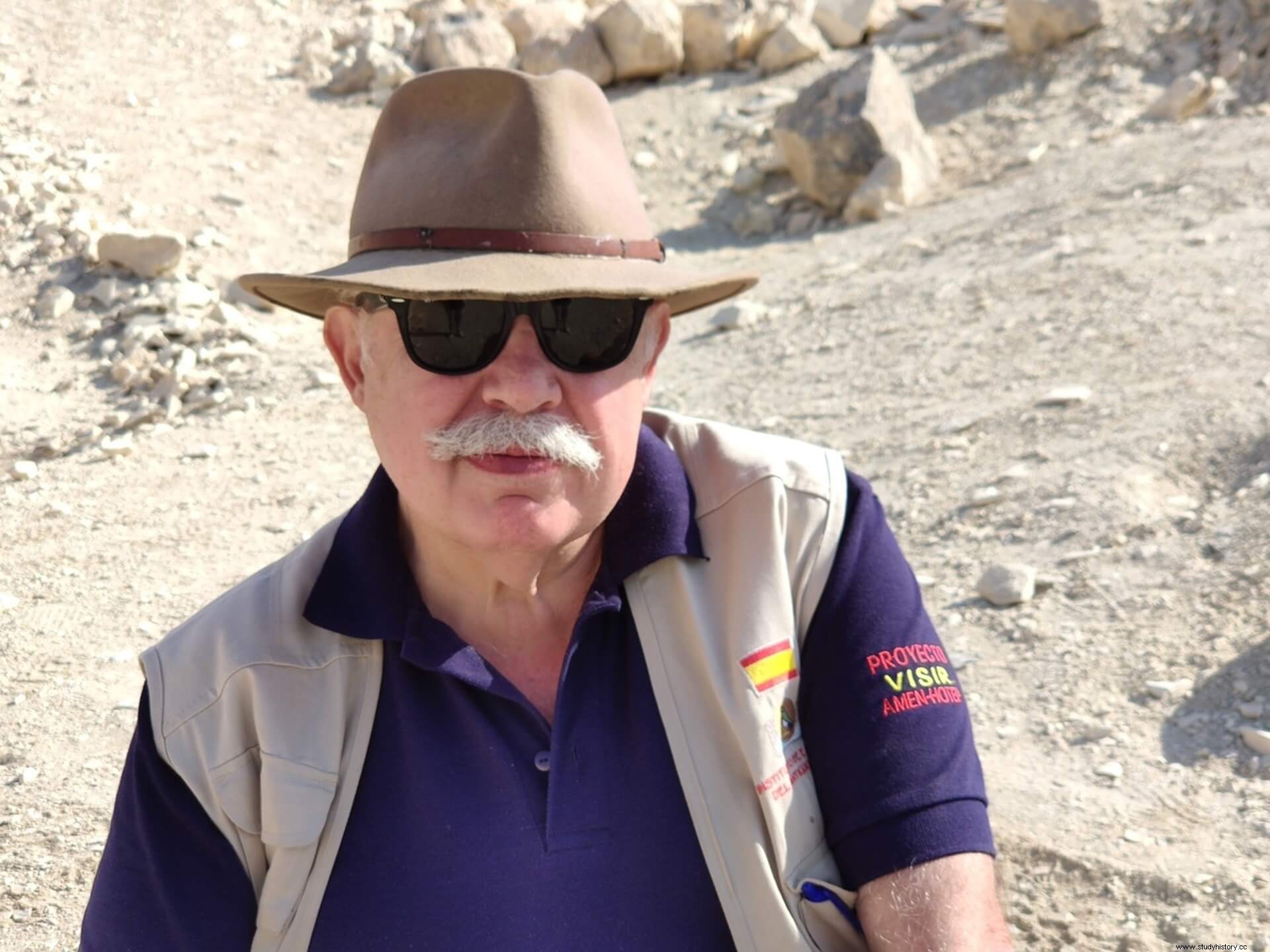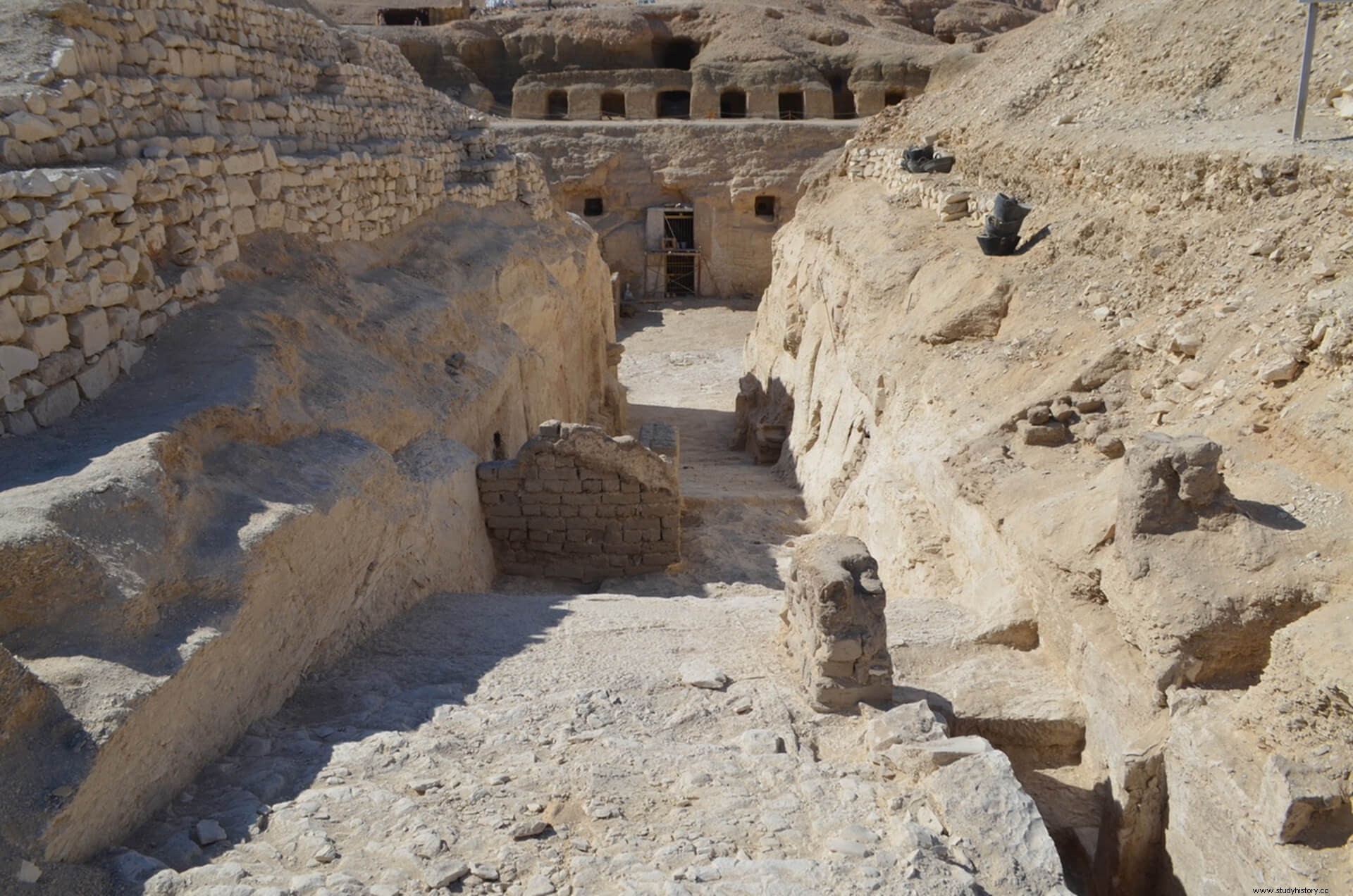
Teresa Bedman She studied Egyptology in Manchester and is an Honorary Member of the Mexican Society of Egyptology or the Sophia Foundation of Palma de Mallorca, among others. She specialized in the female role in Egypt, she has published books such as Hatshepsut, from queen to pharaoh of Egypt (Madrid, 2009) or Queens of Egypt:the secret of power (Madrid, 2003). For her part, Francisco Martín Valentín He has a doctorate in Religious Sciences from the Complutense University, in addition to being the founder of the Spanish Association of Egyptology (1986), of which he was president until 1997. He has published books such as Egyptian Grammar:Initiation to the Egyptian Hieroglyphic System (Madrid, 1989) or The Magicians of Ancient Egypt (Madrid, 2002). In addition to the coordination of the Visir Amen-Hotep Huy Project in Egypt, both teach at the IEAE and in the Master of History and Literary Heritage of Antiquity at the University of Malaga. Likewise, they have curated exhibitions such as “From Life to Death in Ancient Egypt” (Pontevedra Museum) or “Egyptian Blues” (Conde Duque, Madrid).
Question:The Institute for Ancient Egyptian Studies has a long tradition of excavation in Egypt? what balance do you make Are you from these years?
Francisco:We have been excavating in Egypt for about twenty years, with the Institute of Ancient Egyptian Studies, in two very interesting projects. The first was related to the tomb of Sen en-Mut (architect of Hatshepsut), inside which the first astronomical ceiling of Humanity is housed, which makes it unique. The second is that of the tomb of the vizier Amenhotep Huy, which is the one that we are developing right now, since 2009. It is a huge tomb, of royal dimensions, worthy of a pharaoh and belongs to the end of the 18th dynasty, to a vizier about whom, before the excavation, little was known. It has been essential to know a period as particular as the one prior to Akhenaten's revolution.
Q:There have been very important discoveries, such as those that allow us to speak of a co-regency between Amenhotep III and Amenhotep IV
F.- The subject of co-regency has been highly debated since the beginning of the 20th century, and there were visionary articles in the 50s, but material evidence was lacking. In addition, many researchers had chosen to reject this theory, and some had even described it as "fictional history", but it seems to me that everything must always be examined and debated. In history we cannot take anything for granted.
This discovery also changes everything in terms of Akhenaten's family relationships, how the Amarna revolution unfolds, and the ideas surrounding it. The deposit is unique. Also, when you read the history books, the process of the Amarna revolution is mentioned in passing, it seems that there was no opposition. This tomb shows us, perhaps, one of the leaders of that resistance to Atonian change and how he suffered political repression for it.
Teresa:We discovered, already at ground level, the remains of some columns that show the cartouches of Amenhotep III and Amenhotep IV, before changing his name to Akhenaten. And besides, they are clearly dated. Furthermore, there is no possibility of a subsequent trimming, because it is obvious that they are executed by the same hand. So they are indisputable proof. But these processes, especially in such deep-rooted discussions, are always slow, and until the books are changed and they pass into the collective imagination, it will take a long time.
It is also curious that it appeared on November 4, the same day that the first step of Tutankhamun's tomb was discovered. It was a curious coincidence, although we didn't realize it until we were documenting it in the diary (laughs).
F.- In fact, we have already presented our discoveries in two international congresses of Egyptologists, and nobody discussed the validity of them, despite the fact that many of the Egyptologists were present there contrary to the idea of co-regency... and, as they say, whoever is silent grants (while smiling). The truth is that we have been very lucky with the nature of the documents discovered by us, they are clearly indisputable.

Q:Or good eye…
F:Well, we knew that if there was evidence of co-regency, there was a good chance they were in this tomb, which hadn't been excavated before. We had that hope, and in the end it has come out.
And it should be noted that it has been Spanish Egyptology that has had the honor of making such a discovery, and that, therefore, it is leading the way in this issue of coregency. The English, the French or the Germans have always been very proud of their schools, and the Spanish are still just starting. The deposit is unique. We arrived at this privileged archaeological site and now we are in a position to propose a profound revision of the traditional approach to the end of the 18th dynasty, and that does not happen to just anyone.
P.-Tambi There have been problems, I suppose, with the crisis, the political situation in Egypt…
F:The truth is that everything has caught us (laughs). That without counting on the coordination of the entire team. It is also a technically complicated excavation, it is a very large tomb that was full of rubble.
T:(points) About six meters of average depth of deposits… the door was not visible when we started
F:There is still a lot of restoration work left, and besides, there are thousands of fragments. In any case, we have been developing, while the excavation work was being carried out, the pertinent consolidation and restoration tasks. Restoring when you still have it fresh is not the same as it is ten years later, no matter how good the documentation is.

Q:All history is history contemporary What What does Egypt teach us?
F:If we start from the interest that the whole subject of monotheistic religions and their origin supposes, as well as the role that has traditionally been attributed to Egypt in this subject, of course which is still a very sensitive matter. That's important.
But, beyond that, every time we can reveal a life, a gesture, an intention of the owners of those tombs, we learn a little more about our past. And our current time, so global and so stressful, sometimes requires a stop from time to time to look back and refer to ourselves in relation to the thinking and ethics of the past. I think especially in these times we have a great need for it.
P:That's where it comes in too in the challenge of disclosure… and more in a story as mythologized as the Egyptian
F.- The historian must try to present the facts as they are supposed to have been, moving away from mythifications.
The Amarna period is a good example. It has been romanticized a lot, especially from the historical novels, but, in reality, it was not pretty; children have been found starving to death, with bone deformities from overwork, as food rotted in the sun. Akhenaten is highly mythologized, but he was a dictator. Furthermore, it is known that, after the Amarna period, the Egyptian people quickly returned to their traditions, and we also know that during the period of Akhenaten for example, there was resistance to abandoning the use of traditional amulets, as well as the cult of the ancients. gods. In fact, the vizier Amenhotep was a persecuted character, we could almost call him a martyr.
Neither can we say that Akhenaten was good, or bad (Teresa makes a gesture of being less convinced of this). The great changes of humanity have usually occurred in the midst of harsh circumstances, and that is something that history teaches us. You have to understand the facts in their context. It's like, for example, the French Revolution, it had positive and negative things, but no one can deny that Western society, as we know it, is a consequence of those events.
P:Have You have a strong commitment to education and training.
F.- We believe that we owe a lot to society, and that we have to give something back. In addition, the Institute is basically financed with private funds, we have a strong social presence, and that makes us even more aware of this obligation to society. It's worth nothing if we just go, dig, publish and that's it... the project we lead has to revert to the community in different ways, we have to involve them.
T.- In addition to the cooperation in the master's degree with the University of Malaga, we have courses, talks, but also workshops in schools, for example. Children usually like the morbilo of the mummies and how they were prepared (laughs). So they can learn about Egypt beyond what they read on the internet.

Q:And also he n have he is a country school
T.- Yes, that is fundamental. That students can learn in the same excavation.
F.- It is also open to master's students, doctoral students... It is important that they can learn from the beginning, although the team that works in the excavation is, naturally, made up of professionals , for obvious reasons.
T.- We have thousands of requests, and not only from Spain, but from half the world; it is difficult to choose the ones that are going to go to each excavation. When you come to Egypt to work, there are some of the first-time recruits who discover that this is not what they thought. It's hard getting up every day at five in the morning, dealing with the dust, the mosquitoes... but, nevertheless, there are others who reaffirm that Egyptology is their vocation. And we have created a team worth gold. Not everyone can come every year, but many repeat. It is also a pride to see how they are valued abroad and that having participated in our project helps them get a job. They come out very well prepared.
Q.- The discovery of the singer's sarcophagus was very loud, was there, then, a reuse of the tomb in he few later?
T.- Yes, there was a memory of the figure of the vizier as a kind of "holy man", and that made the tomb a prestigious place. In fact, we discover many of the so-called "request ears", as a votive offering, which the Theban people left at the door of the tomb so that the vizier would listen to their requests, as they considered him an intermediary before the god Osiris.
F.- This discovery, along with others made as a result of our work on the tomb of the vizier, have allowed us to get closer to the daily life of the people of Thebes, as it was and it evolved over nearly 1,600 years of history, from the time of Amenhotep III and Akhenaten, to the Roman period, and that's a huge chronological journey.
T.- In fact, this last year we have found magnificent examples of ceramics from the Roman period, many of them complete. Really wonderful ceramics.

It is a good thing the importance that been charging that study of everyday life in historiography. Egypt is also a society in which women had more rights than others like the Greek or Roman, right?
F.- We should learn from this. Since we are talking about what Egyptian history teaches us, one of his most important contributions was equal treatment between women and men. Women in Egypt enjoyed a personal status far superior to that which existed for them in much later societies. This fact is confirmed, for example, by observing that for analogous chronologies and social strata, the same mummification techniques were used for the bodies, whether they were men or women. We still have to study the contents of the discovered tombs, belonging to the Roman period, but everything indicates that, at that time, the same circumstances subsisted (Teresa nods). On the other hand, to talk about the social situation of women in ancient Egypt I do not like to use the term "egalitarian", perhaps it would be more appropriate to use "balanced". We could say that the women acted according to a role yes aco and men according to another Osiriac , both complementary…
There was also attention to childhood, or old age. They were even the first ecologists, and among the negative statements of the dead we find things like "I have not thrown garbage into the river."
In addition, women had a great influence on power. I also believe that the role of women in the Amarna revolution has also been underestimated, and that the female members of the royal family had a lot of influence in these changes, which were not just Akhenaten's thing. I already dealt with this issue of the exercise of power by Egyptian women in the book Queens of Egypt, the secret of power Although I would have liked to develop it more. The truth is that it was a very advanced society on these issues (or we are very backward, Francisco points out). They invented everything... including beer, what better invention? (laughs).
P:And without aliens…
F.- I think the most plausible explanation to understand how they could do everything they did, which amazes us so greatly, lies in the fact that they were deeply spiritual people , at least the members of the ruling elites of society. They deeply believed in what they were doing and knew why they were doing it.
T.- They had very strong spiritual values and a deep belief in Maat, the order of the universe. And they were perfectionists, a bit like traditional Japanese culture. Everything was imbued with a spiritual value in itself. In this way, they had to do things well and consequently the universe would function at the same level of harmony and perfection:the Nile would grow and the whole of Egypt would live in harmony and balance. They were convinced that everyone and everything was part of the same universal order.
Q:It's nice to end the interview with this reflection. Thank you both very much!

